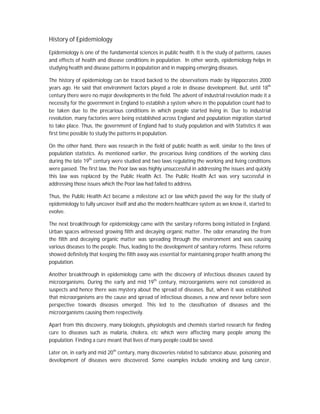History of Epidemiology, Epidemiology Assignment Help
Epidemiology is the study of patterns, causes, and effects of health and disease conditions in populations. It has its origins in observations by Hippocrates 2000 years ago noting environmental influences on disease. Formal study of epidemiology began in the 18th century with the industrial revolution in England, when the precarious living conditions of factory workers necessitated the first population counts and public health research. The 19th century Public Health Act was a milestone that allowed epidemiology to fully develop and modern healthcare systems to evolve by addressing health issues. Later, sanitary reforms and the discovery that microorganisms cause infectious disease provided new perspectives that advanced epidemiology through disease classification and searches for cures. Epidemiology has since played a

Recommended
More Related Content
What's hot
What's hot (20)
Similar to History of Epidemiology, Epidemiology Assignment Help
Similar to History of Epidemiology, Epidemiology Assignment Help (20)
Recently uploaded
Recently uploaded (20)
History of Epidemiology, Epidemiology Assignment Help
- 1. History of Epidemiology Epidemiology is one of the fundamental sciences in public health. It is the study of patterns, causes and effects of health and disease conditions in population. In other words, epidemiology helps in studying health and disease patterns in population and in mapping emerging diseases. The history of epidemiology can be traced backed to the observations made by Hippocrates 2000 years ago. He said that environment factors played a role in disease development. But, until 18th century there were no major developments in the field. The advent of industrial revolution made it a necessity for the government in England to establish a system where in the population count had to be taken due to the precarious conditions in which people started living in. Due to industrial revolution, many factories were being established across England and population migration started to take place. Thus, the government of England had to study population and with Statistics it was first time possible to study the patterns in population. On the other hand, there was research in the field of public health as well, similar to the lines of population statistics. As mentioned earlier, the precarious living conditions of the working class during the late 19th century were studied and two laws regulating the working and living conditions were passed. The first law, the Poor law was highly unsuccessful in addressing the issues and quickly this law was replaced by the Public Health Act. The Public Health Act was very successful in addressing those issues which the Poor law had failed to address. Thus, the Public Health Act became a milestone act or law which paved the way for the study of epidemiology to fully uncover itself and also the modern healthcare system as we know it, started to evolve. The next breakthrough for epidemiology came with the sanitary reforms being initiated in England. Urban spaces witnessed growing filth and decaying organic matter. The odor emanating the from the filth and decaying organic matter was spreading through the environment and was causing various diseases to the people. Thus, leading to the development of sanitary reforms. These reforms showed definitely that keeping the filth away was essential for maintaining proper health among the population. Another breakthrough in epidemiology came with the discovery of infectious diseases caused by microorganisms. During the early and mid 19th century, microorganisms were not considered as suspects and hence there was mystery about the spread of diseases. But, when it was established that microorganisms are the cause and spread of infectious diseases, a new and never before seen perspective towards diseases emerged. This led to the classification of diseases and the microorganisms causing them respectively. Apart from this discovery, many biologists, physiologists and chemists started research for finding cure to diseases such as malaria, cholera, etc which were affecting many people among the population. Finding a cure meant that lives of many people could be saved. Later on, in early and mid 20th century, many discoveries related to substance abuse, poisoning and development of diseases were discovered. Some examples include smoking and lung cancer,
- 2. mercury poisoning, etc. These studies and discoveries have all been made possible by the application of the study of epidemiology. Thus, epidemiology has taken one of the most important places in public health. In one way, it has become indispensible for almost all the governments across the globe to include epidemiology in public health and include it in the study of medicine and related fields. For more details, please visit our website www.helpwtihassignment.com.
